ACU-T: 3311 Multiphase Nucleate Boiling Using the Algebraic Eulerian Model
Tutorial Level: Intermediate
This tutorial provides instructions for modeling a two-phase nucleate boiling in a pipe using the Algebraic Eulerian model. Prior to starting this tutorial, you should have already run through the introductory tutorial, ACU-T: 1000 UI Introduction, and have a basic understanding of HyperMesh CFD and AcuSolve. To run this simulation, you will need access to a licensed version of HyperMesh CFD and AcuSolve.
Problem Description
The problem to be addressed in this tutorial is shown schematically in Figure 1. It consists of a channel with a heated wall at the bottom. The temperature of the wall is selected to onset the nucleate boiling at the heated wall.
Water at 2 bar pressure and 95 ℃ temperature enters the inlet at an average velocity of 0.39 m/sec and passes through the heated wall which is maintained at 130 ℃.
The pre-heated air enters the inlets and heat is transferred to the fluid from the walls. The heat causes sub-cooled boiling to occur in the region close to the wall and leads to formation of bubbles at nucleation sites.
The heat transfer in this regime is basically dominated by two effects, the macro convection due to the motion of the bulk liquid and the latent heat transport associated with the evaporation of the liquid micro-layer between the bubble and the heated wall.

Start HyperMesh CFD and Open the HyperMesh Database
- Start HyperMesh CFD from the Windows Start menu by clicking .
-
From the Home tools, Files tool group, click the Open Model tool.
Figure 2. 
The Open File dialog opens. - Browse to the directory where you saved the model file. Select the HyperMesh file ACU-T3311_TwoPhaseNB.hm and click Open.
- Click .
-
Create a new directory named NB2 and navigate into this directory.
This will be the working directory and all the files related to the simulation will be stored in this location.
- Enter NB2_Steiner as the file name for the database, or choose any name of your preference.
- Click Save to create the database.
Validate the Geometry
The Validate tool scans through the entire model, performs checks on the surfaces and solids, and flags any defects in the geometry, such as free edges, closed shells, intersections, duplicates, and slivers.

Set Up Flow
Verify and Create Materials
-
From the Flow ribbon, click the Material Library tool.
Figure 4. 
The Material Library dialog opens. - Under Settings, click Fluid, and then click the My Materials tab.
-
Verify that the material Water_NB has the properties shown below.
Figure 5. 
- Under Settings, click Boiling Multiphase, and then click the My Materials tab.
-
Click
 to create a new material.
to create a new material.
-
Name the material Boiling_NB and verify the following
properties in the microdialog.
Figure 6. 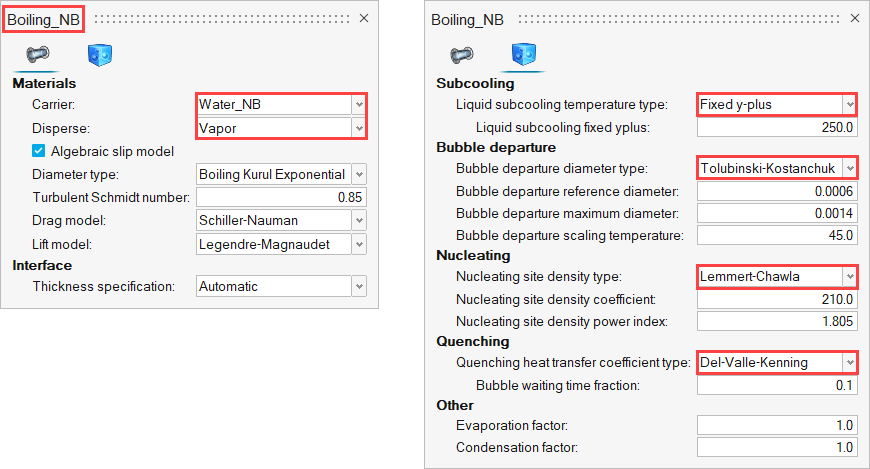
Set the General Simulation Parameters
-
From the Flow ribbon, click the Physics tool.
Figure 7. 
The Setup dialog opens. -
Under the Physics models setting:
- Activate the Multiphase flow radio button.
- Set the Multifluid type to Boiling and the Boiling material to Boiling_NB.
- Ensure that the Time step size is 0.01.
- Select Spalart-Allmaras as the Turbulence model.
- Set the Gravity value to -9.81 in the z direction.
-
Set the Pressure scale to Gauge then click
 besides the drop-down and set the Absolute
pressure offset to 200000.
besides the drop-down and set the Absolute
pressure offset to 200000.
Figure 8. 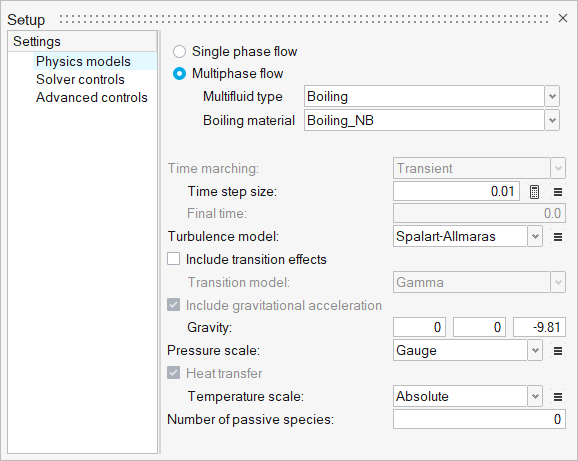
-
Click the Solver controls setting and verify that:
- Minimum stagger iteration is set to 2.
- Maximum stagger iteration is set to 4.
- Transient maximum step is set to 40.
- The Flow, Temperature, Multifluid, and Turbulence checkboxes are activated.
Figure 9. 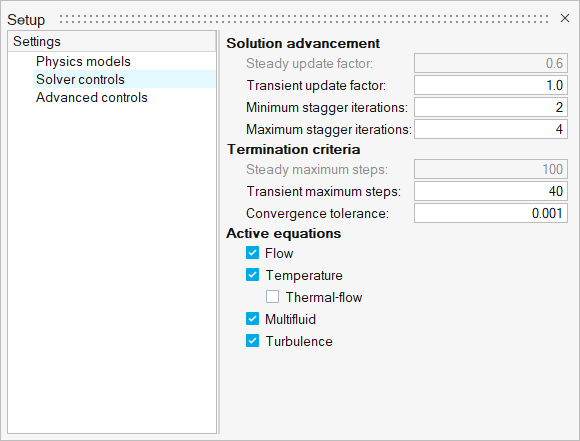
- Close the dialog and save the model.
Assign Material Properties
-
From the Flow ribbon, click the Material tool.
Figure 10. 
- Select the model solid.
-
Select Boiling_NB from the Material drop-down
menu.
Figure 11. 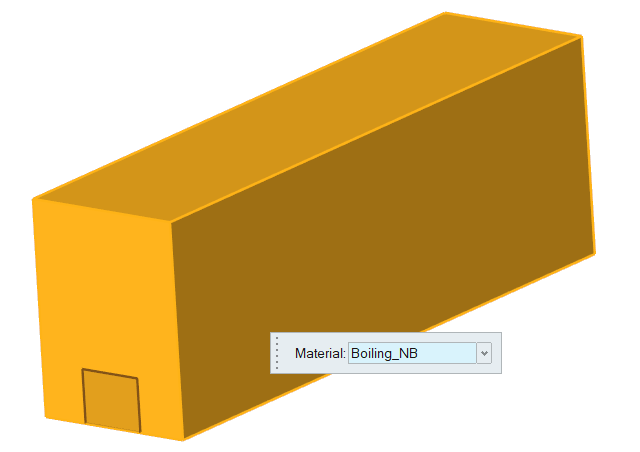
-
On the guide bar, click
 to execute
the command and exit the tool.
to execute
the command and exit the tool.
Define Flow Boundary Conditions
-
From the Flow ribbon, Profiled
tool group, click the Profiled Inlet tool.
Figure 12. 
- Click the inlet face, highlighted in the figure below.
-
In the microdialog, enter 0.39
for the Average velocity and 368.15 for the
Temperature.
Figure 13. 
-
On the guide bar, click
 to execute
the command and exit the tool.
to execute
the command and exit the tool.
-
Click the Outlet tool.
Figure 14. 
-
Select the face highlighted in the figure below and then click
 on the
guide bar.
on the
guide bar.
Figure 15. 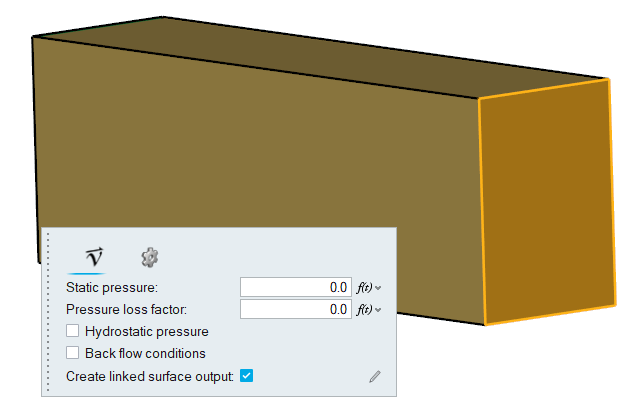
-
Click the No Slip tool.
Figure 16. 
-
Select the face highlighted in the figure below to create the Heated_wall
face.
Figure 17. 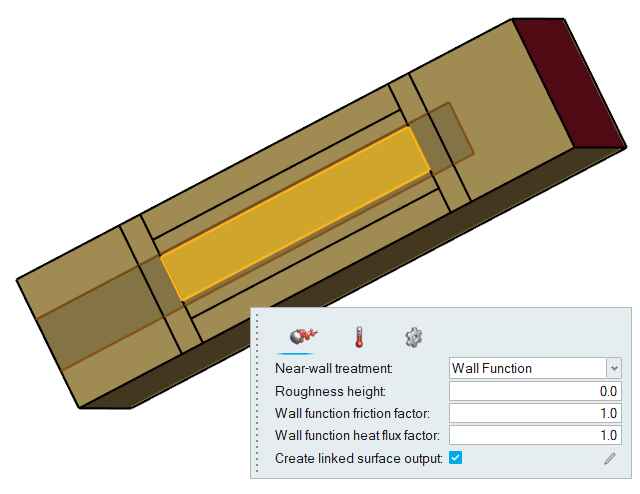
-
Click the Temperature tab in the microdialog, set the
Thermal Boundary condition to Temperature, and set the
Temperature value to 403.15.
Figure 18. 
-
On the guide bar, click
 to execute the command and remain in the
tool.
to execute the command and remain in the
tool.
-
In the Boundaries legend, right-click Wall, select
Rename, and enter
Heated_wall.
Figure 19. 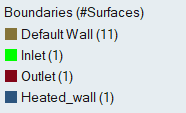
-
Select the 8 highlighted surfaces shown in the figure below to create the
Bottom_wall faces and then click
 on the guide bar.
on the guide bar.
Figure 20. 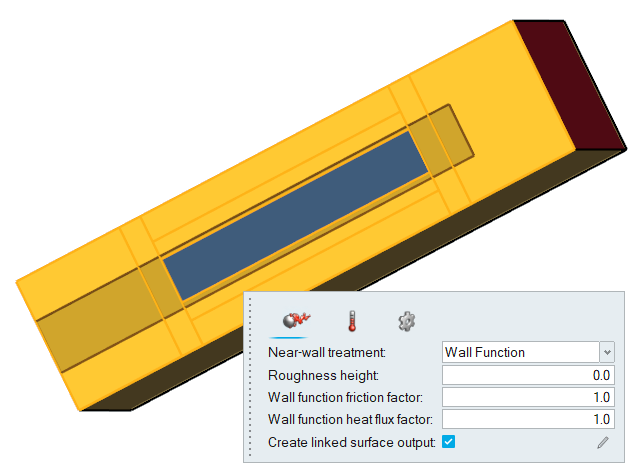
- In the Boundaries legend, rename Wall to Bottom_wall.
-
From the Solution ribbon, click the Field tool.
Figure 21. 
The Field Output dialog opens. -
Set the Time step interval to 10.
Figure 22. 
- Save the model.
Generate the Mesh
-
From the Mesh ribbon, click the
Volume tool.
Figure 23. 
-
In the Meshing Operations dialog, set the Average Element
size to 0.004 (if not set already).
Figure 24. 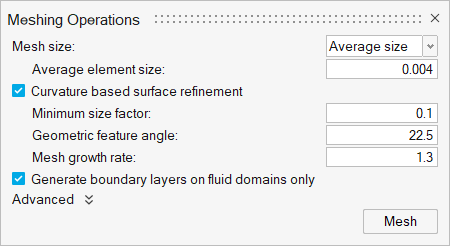
-
Click Mesh.
The Run Status dialog opens. Once the run is complete, the status is updated and you can close the dialog.Tip: Right-click the mesh job and select View log file to view a summary of the meshing process.
- Save the model.
Run AcuSolve
-
From the Solution ribbon, click the Run tool.
Figure 25. 
The Launch AcuSolve dialog opens. - Set the Parallel processing option to Intel MPI.
- Optional: Set the number of processors to 4 or 8 based on availability.
- Check the box for Use hybrid message passing and set the number of threads to the same as the number of processors.
-
Expand Default initial conditions and enter the values
as shown below to define the initial conditions.
Figure 26. 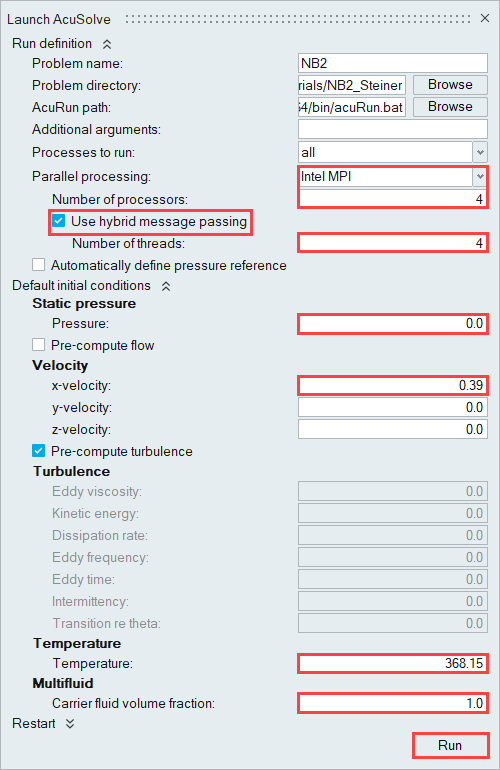
-
Click Run to launch AcuSolve.
The Run Status dialog opens. Once the run is complete, the status is updated and you can close the dialog.Tip: While AcuSolve is running, right-click the AcuSolve job in the Run Status dialog and select View Log File to monitor the solution process.
Post-Process the Results with HM-CFD Post
- Once the solution is completed, navigate to the Post ribbon.
- From the menu bar, click .
-
Select the AcuSolve
.log file in your problem
directory to load the results for post-processing.
The solid and all the surfaces are loaded in the Post Browser.
Figure 27. 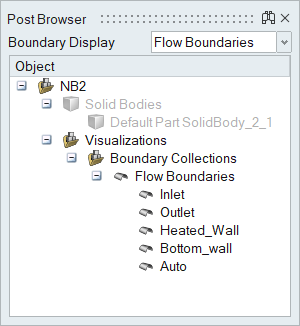
- To check the contours of volume fraction of vapor on the Heated_Wall and Bottom_wall surfaces, right-click those surfaces in the Post Browser and select Isolate.
-
From the Post ribbon, click the Boundary Groups
tool.
Figure 28. 
- Select all the surfaces on the model.
- In the microdialog, set the Display option to volume fraction vapor.
-
Activate the Legend radio button and then click
 and set the legend properties as
shown below.
and set the legend properties as
shown below.
Figure 29. 
-
Click
 on the guide bar.
on the guide bar.
-
Move the slider at the bottom of the modeling window to
4/4.
The volume fraction of vapor contours are displayed on the model.
Figure 30. 
Summary
In this tutorial, you successfully learned how to set up and solve a simulation involving a two-phase nucleate boiling using HyperMesh CFD. You started by opening the HyperMesh input file with the geometry and then defined the simulation parameters and flow boundary conditions. Once the solution was computed, you used HyperMesh CFD Post to create the contours of volume fraction of vapor.